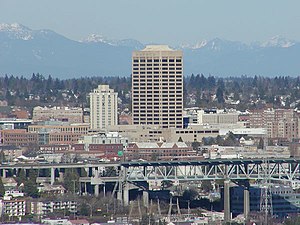
Urban universities seem to have a long history of being bullies in the communities in which they reside. There’s the fact that universities are big businesses, with all the power that money brings. Then there’s the influence of the widely held belief that universities are a public good and are, therefore, above reproach. People typically don’t want to be seen as blockers of progress, as being against the building of classrooms, scientific labs, and hospitals—and all the additional jobs that go with them. But are universities good for the health of their own communities?
I’m thinking about the university campus-community where I currently live and work: the University of Washington and the U-District. In the past two decades I have seen the university steadily creeping westward through the heart of the U-District neighborhood, building palatial new student dorms, new research and technology buildings, branch medical centers, and even taking over the hulking Tower of Saurumon—oh wait, it’s really called the UW Tower. This is the former SAFECO insurance company building, which at 22-stories is the tallest building in Seattle outside of the downtown business core. You have to be here to understand just how much of a commanding presence this building has for the surrounding neighborhood. There is no place to hide from it. Fittingly, back in the 1960’s or 70’s, the SAFECO tower had a 96-foot long reader board with flashing light messages such as “Big brother is watching you.” Now the top of the tower just says “UW” in big purple letters (the ‘is watching you’ part is, perhaps, understood.)
There is a new U-District revitalization group working on ways to reduce crime, increase (legitimate) businesses, and make the U-District healthier and more livable. The group has representatives from the University of Washington, the U-District business groups, residents of the U-District, and at least one community service provider who works with homeless people in the U-District. I have a personal interest in the success of this group since I own a home near the University, I bike to my office at the University, I dine and shop in the U-District, and I do some volunteer work at a U-District homeless shelter. Mine is a cautionary optimism about the success of the revitalization group. My caution comes from looking at the community-campus ‘revitalization’ that has happened recently in the city I moved to Seattle from: Baltimore.
I lived, worked and went to school in the East Baltimore area where Johns Hopkins Hospital is located. As a neighborhood, East Baltimore certainly had its problems—mainly deeply entrenched poverty, stemming in large part from historical racism. It was a majority African-American community. But it was a community in the true sense of the term, and I found from working with the residents that there were amazing sources of community resiliency and pride. These sources of community resiliency could have been built upon for the mutual benefit of the ‘real’ community and of the Johns Hopkins community. Although there are small examples of this happening, they are all dwarfed by the following facts:
In 2002, spurred on by an Irish-American Baltimore City mayor, Johns Hopkins University partnered with the city and state governments, and with the Annie E. Casey Foundation to begin a 20-year $1.8 billion East Baltimore revitalization effort. Approximately 90 acres of residential area just north of the Johns Hopkins Hospital were bought up, 800 families were displaced, and their houses torn down. These houses are slowly being replaced by life sciences buildings, student dorms, and high-end townhouses and apartment buildings. Various sources of Johns Hopkins University publicity for this project that I’ve reviewed, gleefully state that the ‘urban blight’ has been wiped out and that crime in the area has been reduced by 87% since 2002 (well duh, you need people to have crime, right?). None of the reports mention what has really happened to the 800 displaced African-American families, nor what they think of this seemingly non-participatory (or bullying) university neighborhood ‘revitalization’ project. (see “The changing face of East Baltimore” by Greg Rienzi, Jan 1, 2012/JHU Gazette.)
I hope that my own university and community can do better than this….
For a brief and fascinating history of UW/U-District relationships, see the Washington State Historylink file “Seattle Neighborhood: University District Thumbnail history.” Who knew that the world’s largest single university building, the UW Health Sciences Building, came about because the UW football team won the Rose Bowl in 1960? Now I know why it’s so important for the UW to be building a new $261 million Husky football stadium.
